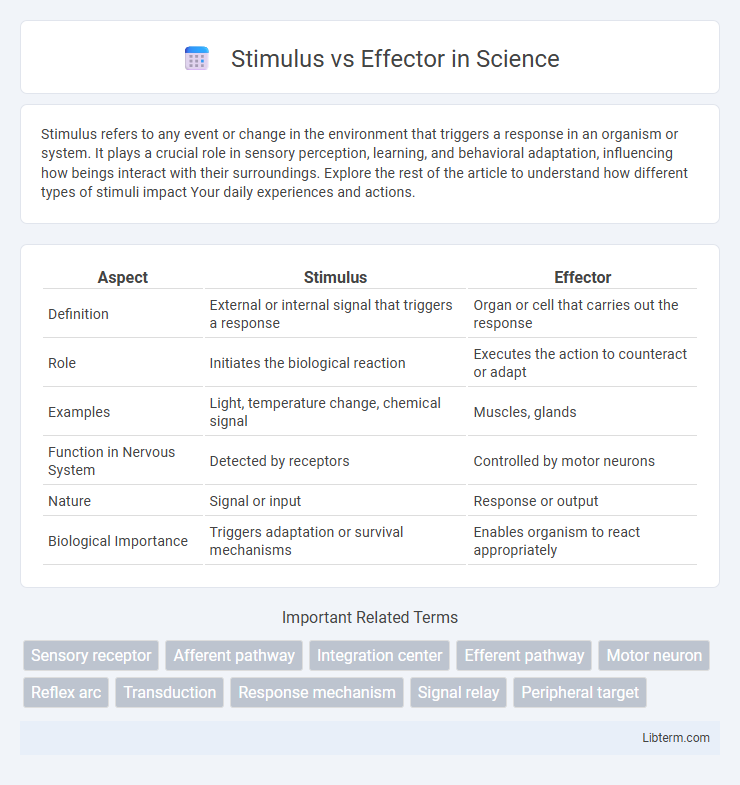Stimulus refers to any event or change in the environment that triggers a response in an organism or system. It plays a crucial role in sensory perception, learning, and behavioral adaptation, influencing how beings interact with their surroundings. Explore the rest of the article to understand how different types of stimuli impact Your daily experiences and actions.
Table of Comparison
| Aspect | Stimulus | Effector |
|---|---|---|
| Definition | External or internal signal that triggers a response | Organ or cell that carries out the response |
| Role | Initiates the biological reaction | Executes the action to counteract or adapt |
| Examples | Light, temperature change, chemical signal | Muscles, glands |
| Function in Nervous System | Detected by receptors | Controlled by motor neurons |
| Nature | Signal or input | Response or output |
| Biological Importance | Triggers adaptation or survival mechanisms | Enables organism to react appropriately |
Understanding Stimulus and Effector: Basic Definitions
A stimulus is any external or internal change that triggers a response in an organism, such as temperature shifts or light intensity. An effector is the muscle or gland that acts in response to the stimulus, facilitating movement or secretion to restore balance. Understanding these concepts is fundamental in physiology for analyzing how organisms perceive and adapt to environmental changes.
The Biological Pathway: From Stimulus to Response
The biological pathway from stimulus to response begins when a sensory receptor detects a specific stimulus intensity, triggering a neural signal that transmits information to the central nervous system. This signal is processed, and an appropriate effector, such as a muscle or gland, is activated to produce a physiological response aimed at maintaining homeostasis. The efficiency of this pathway relies on the precise communication between sensory neurons, interneurons, and motor neurons, ensuring rapid and coordinated responses to environmental changes.
Types of Stimuli in Organisms
Stimuli in organisms are categorized into external and internal types, with external stimuli including factors such as light, temperature, sound, and chemical signals from the environment, while internal stimuli involve changes within the organism like hormone levels, blood sugar concentration, and muscle stretch. Sensory receptors detect these stimuli, triggering specific responses via effectors such as muscles or glands to maintain homeostasis or adapt behavior. Understanding the diverse stimuli types is crucial for studying organismal interaction with their environment and regulatory mechanisms.
Common Effectors in Human and Animal Bodies
Common effectors in human and animal bodies include muscles and glands, which respond to stimuli by producing movement or secreting hormones. Skeletal muscles enable voluntary motion, while smooth and cardiac muscles control involuntary actions like digestion and heartbeat. Glands such as sweat, salivary, and endocrine glands release substances that regulate physiological processes in response to nervous system signals.
The Role of Receptors in Stimulus Detection
Receptors play a crucial role in stimulus detection by sensing specific environmental changes such as temperature, pressure, or chemical signals. These specialized cells convert stimuli into electrical impulses that are transmitted to the central nervous system for processing. Effective receptor function ensures accurate signal reception, which is essential for the effector organs to respond appropriately and maintain homeostasis.
Nervous System Involvement: Transmitting Signals
Stimulus triggers sensory receptors in the nervous system to generate electrical impulses that travel via afferent neurons to the central nervous system for processing. Effector organs receive signals through efferent neurons, enabling motor responses like muscle contraction or gland secretion. This coordinated transmission of signals ensures rapid communication and immediate reaction to environmental changes.
Stimulus vs Effector: Key Differences
Stimulus refers to any change in the internal or external environment that triggers a response, while an effector is the organ or cell that acts to carry out the response to the stimulus. The stimulus initiates the signaling process, whereas the effector executes the corrective or adaptive action, such as muscle contraction or gland secretion. Understanding this distinction is crucial for comprehending how organisms maintain homeostasis through feedback mechanisms.
Examples of Stimulus-Effector Mechanisms
A stimulus such as a sudden drop in temperature triggers thermoreceptors in the skin, which send signals to the brain, activating effectors like muscles to induce shivering and generate heat. In plants, exposure to light acts as a stimulus detected by photoreceptors, causing effectors such as auxin hormones to redistribute, leading to phototropism where the plant bends toward the light source. During a tendon reflex, a stretch stimulus on the patellar tendon is detected by muscle spindles, sending impulses to the spinal cord that result in effector muscle contraction to maintain posture.
Disorders Involving Stimulus or Effector Malfunction
Disorders involving stimulus or effector malfunction disrupt normal sensory or motor functions, such as neuropathies affecting sensory receptors or motor neurons. Conditions like multiple sclerosis impair signal transmission between stimuli and effectors, leading to muscle weakness or loss of sensation. Damage to effectors, such as muscle dystrophies, results in voluntary movement difficulties despite intact stimuli reception.
Importance of Stimulus-Effector Relationships in Homeostasis
The precise interaction between stimulus and effector is critical for maintaining homeostasis, as it ensures the body can detect changes and initiate appropriate responses to restore balance. Effectors, such as muscles or glands, act on signals triggered by specific stimuli to regulate internal conditions like temperature, pH, or glucose levels. Disruptions in stimulus-effector communication can lead to homeostatic imbalances, resulting in physiological disorders or diseases.
Stimulus Infographic

 libterm.com
libterm.com